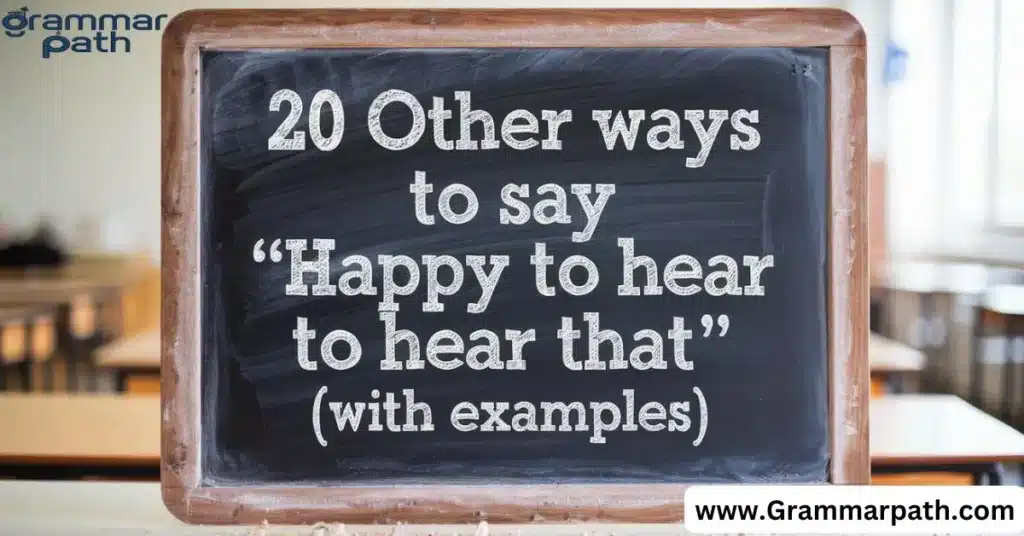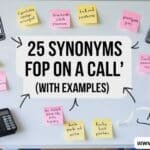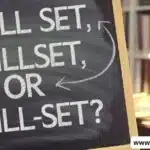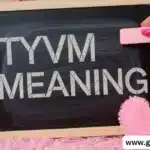Happy to hear that it’s a phrase we’ve all used countless times, but have you ever stopped to consider its impact? In a world where communication is key, the way we express joy and support can make all the difference. Whether you’re responding to good news from a friend, acknowledging a colleague’s success, or sharing in a loved one’s excitement, your choice of words can elevate the moment from ordinary to extraordinary.
Imagine a canvas of conversation, where each phrase is a brushstroke of emotion. By expanding your repertoire beyond the familiar “happy to hear that,” you’re not just communicating you’re crafting connections. These alternative expressions are like secret ingredients in the recipe of human interaction, adding flavor and depth to your relationships.
In this article, we’ll explore ten fresh and engaging ways to convey your happiness upon receiving good news. We’ll dive into scenarios where each phrase shines, from professional emails to heartfelt text messages. By the end, you’ll have a toolkit of expressions to make your reactions as unique as the moments they celebrate. So, let’s embark on this linguistic journey and discover how a few well-chosen words can transform the way we share in each other’s joy.
What to Say Instead of “Happy to hear that”
- That’s great to hear!
- I’m so glad to hear that.
- That makes me very happy.
- What wonderful news!
- I’m thrilled to hear that.
- That put a smile on my face.
- You’ve made my day with that news.
- I’m so pleased to hear that.
- That’s such a relief to hear.
- I’m delighted that’s the case.
- I’m over the moon about that!
- That’s music to my ears.
- I couldn’t be happier for you.
- This news just made my week!
- I’m absolutely elated to hear that.
- You’ve just brightened my entire day.
- I’m doing a happy dance as we speak!
- This is the best news I’ve heard all day.
- I’m beaming with joy for you.
- That’s absolutely fantastic!
is it Professional to Say: “Happy to Hear That”
While this phrase is generally acceptable in most work settings, its appropriateness depends on context. In formal situations or with senior colleagues, more refined alternatives might be preferable.
However, for everyday office communication, it’s a perfectly fine expression of positivity. The key is to gauge the tone of your workplace and adjust accordingly. When in doubt, opt for slightly more formal variations like “I’m pleased to hear that” or “That’s great news.”
Why Variety in Expression Matters
Before we dive into our list of alternatives, let’s explore why it’s crucial to expand our verbal palette. Using the same phrase repeatedly can make our reactions seem insincere or robotic. By varying our expressions, we:
- Demonstrate genuine engagement: When we tailor our response to the situation, it shows we’re truly listening and care about what’s being shared.
- Enhance emotional connections: Different phrases can convey varying levels of enthusiasm, allowing us to match our response to the magnitude of the news.
- Improve professional communication: In a work setting, diverse language can make you stand out as articulate and thoughtful.
20 Vibrant Alternatives to “Happy to Hear That”
Here are 20 Vibrant Alternatives to “Happy to Hear That”:
1. That’s great to hear!
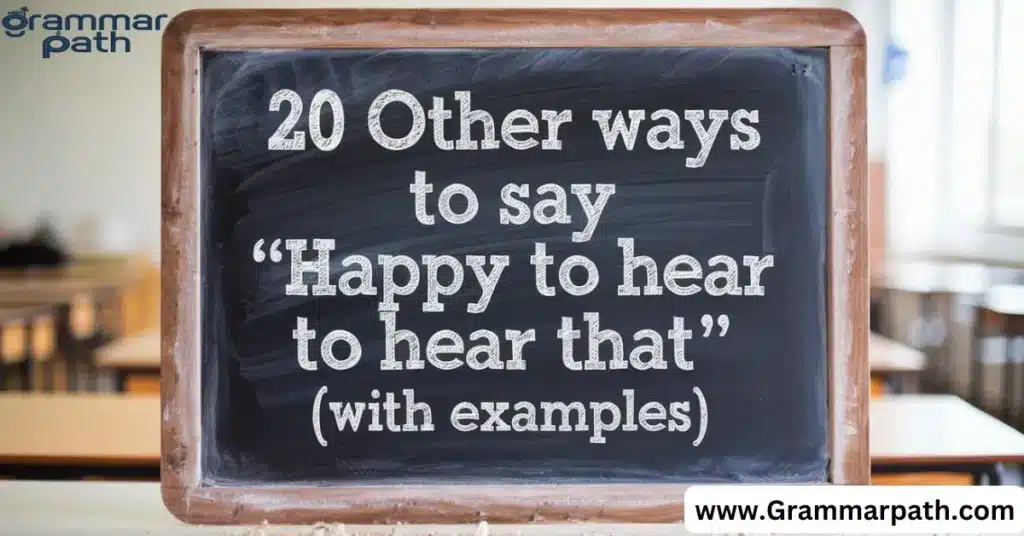
This enthusiastic response works well in both casual and professional settings. It’s a step up from the standard “happy to hear that” without being over the top.
Example scenario (Email):
Subject: Project Greenlight Update
From: Sarah Chen
To: Alex Rodriguez
Hi Alex,
I’ve just reviewed the latest numbers for Project Greenlight. We’re 15% ahead of schedule and 10% under budget!
Best,
Sarah
Reply:
From: Alex Rodriguez
To: Sarah Chen
Sarah,
That’s great to hear! Your team’s efficiency is truly impressive. This puts us in an excellent position for the upcoming quarter. Keep up the outstanding work!
Alex
2. I’m so glad to hear that.
This phrase conveys warmth and personal investment in the news. It’s perfect for more intimate or emotional situations.
Example scenario (Text message):
Friend: Hey! Just got my blood test results back. All clear! 😊
You: Oh, I’m so glad to hear that! I know you’ve been worried. This calls for a celebration! Dinner at your favorite spot this weekend?
3. That makes me very happy.
Use this when you want to emphasize how the news affects you personally. It’s a great way to show empathy and connection.
Example scenario (In-person conversation):
Colleague: I finally got that promotion I’ve been working towards!
You: Wow, that makes me very happy! Your dedication has been inspiring to watch. The team is lucky to have you in this new role.
4. What wonderful news!
This exclamation is perfect for significant announcements or unexpected positive outcomes. It adds a touch of formality while still expressing genuine joy.
Example scenario (Social media comment):
Friend’s post: “We’re expecting! Baby #2 is on the way! 👶🎉”
Your comment: What wonderful news! Your family’s about to get even more adorable. Wishing you all the best during this exciting time!
5. I’m thrilled to hear that.
When you want to convey a higher level of excitement, this phrase does the job beautifully. It’s suitable for both personal and professional contexts.
Example scenario (Business call):
Client: “We’ve decided to go ahead with the full package you proposed.”
You: “I’m thrilled to hear that! Your trust in our services means a lot. I’m confident this comprehensive approach will yield excellent results for your business.”
6. That put a smile on my face.

This casual and friendly response works well in personal relationships. It vividly expresses how the news has positively affected your mood.
Example scenario (Instant message):
Roommate: Hey, remember that stray cat we’ve been feeding? The shelter found her a forever home!
You: Aww, that put a smile on my face! It’s so heartwarming to know she’ll have a loving family. We did good, didn’t we?
7. You’ve made my day with that news.
Use this when the information shared has a significant positive impact on your mood or outlook. It’s a great way to show appreciation for someone sharing good news with you.
Example scenario (Email):
Subject: Family Reunion Update
From: Uncle Bob
To: Extended Family
Hello everyone,
Great news! We’ve secured that beautiful lakeside venue for our family reunion this summer. Looking forward to seeing you all there!
Love,
Uncle Bob
Reply:
From: You
To: Uncle Bob
Uncle Bob,
You’ve made my day with that news! I can already picture us all together by the lake. Thanks for all your hard work in organizing this. Can’t wait to see everyone!
8. I’m so pleased to hear that.
This phrase strikes a nice balance between formal and friendly. It’s particularly useful in professional settings or when responding to acquaintances.
Example scenario (LinkedIn message):
Connection: Hi there! Just wanted to let you know I’ve started my own consulting firm, focusing on sustainable business practices.
You: I’m so pleased to hear that! Your expertise in this field is truly needed. Wishing you all the success in this new venture. Let me know if there’s any way I can support you.
9. That’s such a relief to hear.
When responding to news that resolves a worrying situation, this phrase acknowledges both the positive outcome and the preceding concern.
Example scenario (Phone call):
Friend: “Hey, just got out of surgery. The doctor said they got all of the tumor, and it’s benign!”
You: “Oh my goodness, that’s such a relief to hear! I’ve been thinking about you all day. How are you feeling now?”
10. I’m delighted that’s the case.

This more formal expression works well in professional contexts or when you want to convey happiness with a touch of sophistication.
Example scenario (Work email):
Subject: Quarterly Report Feedback
From: Emma Thompson, CFO
To: Department Heads
Team,
After reviewing all departmental reports, I’m pleased to announce we’ve exceeded our Q3 targets by 12%.
Best,
Emma
Reply:
From: You
To: Emma Thompson
Dear Emma,
I’m delighted that’s the case! This achievement reflects the hard work and dedication of every team member. It’s particularly impressive given the challenges we faced at the beginning of the quarter.
I’d like to propose a company-wide celebration to acknowledge this success. Would you be open to discussing some ideas?
Best regards,
[Your Name]
11. I’m over the moon about that!
This enthusiastic phrase conveys intense happiness and excitement. It’s perfect for responding to significant personal achievements or life-changing news.
Example scenario (Video call):
Friend: “Guess what? I just got accepted into my dream grad school program!”
You: “Oh my gosh, I’m over the moon about that! You’ve worked so hard for this. I can’t wait to see all the amazing things you’ll accomplish there!”
12. That’s music to my ears.
This idiomatic expression is a delightful way to express joy, especially when the news is something you’ve been hoping to hear.
Example scenario (Work chat):
Colleague: Hey [Your Name], the client just signed off on our proposal. We got the project!
You: Wow, that’s music to my ears! Our team’s hard work really paid off. Let’s schedule a quick meeting to plan our next steps.
13. I couldn’t be happier for you.
Use this phrase when you want to emphasize your genuine happiness for someone else’s success or good fortune.
Example scenario (Handwritten note):
Dear Emily,
I heard about your recent promotion to Senior Manager. I couldn’t be happier for you! Your dedication and innovative ideas have always stood out, and it’s wonderful to see them recognized.
Warmest congratulations,
[Your Name]
14. This news just made my week!
When you want to convey that the news has had a significant positive impact on your mood, the phrase “happy to hear that” does the job beautifully.
Example scenario (Social media comment):
Friend’s post: “After months of searching, we’ve finally found our dream home! 🏡❤️”
Your comment: This news just made my week! I know how much this means to you both. Can’t wait for the housewarming party! 🎉
15. I’m absolutely elated to hear that.
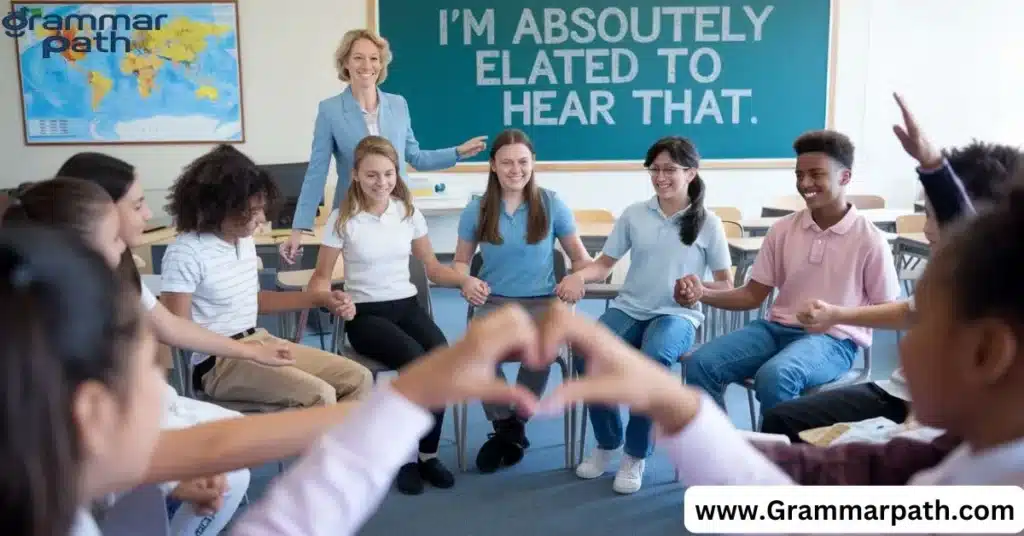
This more formal expression works well in professional settings or when you want to convey a high level of enthusiasm with a touch of sophistication.
Example scenario (Email):
Subject: Grant Approval
From: Dr. Samantha Lee
To: Research Team
Team,
Our grant proposal for the climate change study has been approved for full funding.
Best,
Dr. Lee
Reply:
From: You
To: Dr. Samantha Lee
Dear Dr. Lee,
I’m absolutely elated to hear that! This grant will be transformative for our research. Your leadership in putting together such a compelling proposal was crucial to this success.
I’d love to discuss how we can hit the ground running with this project. Are you available for a brief meeting later this week?
Best regards,
[Your Name]
16. You’ve just brightened my entire day.
This warm, personal response is great for conveying how the news has positively affected your mood.
Example scenario (Text message):
Friend: Hey! Remember that old photo of us from high school I’ve been searching for? I found it!
You: No way! You’ve just brightened my entire day. Those memories are priceless. Can you send it over? We should plan a reunion to recreate that photo!
17. I’m doing a happy dance as we speak!
This playful and energetic response is perfect for casual situations and close relationships. It vividly expresses your joy and excitement.
Example scenario (Phone call):
Sister: “I just felt the baby kick for the first time!”
You: “Oh my goodness, I’m doing a happy dance as we speak! That’s such a special moment. How are you feeling? I wish I could be there with you right now!”
18. This is the best news I’ve heard all day.
Use this when you want to emphasize the positive impact of the news, especially in comparison to other things you’ve heard.
Example scenario (In-person conversation):
Coworker: “Hey, the boss loved your idea for the new project. She wants you to lead the team!”
You: “Wow, this is the best news I’ve heard all day! I’m excited about the opportunity to take on this responsibility. Thanks for letting me know!”
19. I’m beaming with joy for you.
This expressive phrase paints a vivid picture of your happiness. It’s particularly suitable for responding to personal accomplishments or good news from close friends and family.
Example scenario (Greeting card):
Dear Alex and Jamie,
Congratulations on your engagement! I’m beaming with joy for you both. Your love story has been a beautiful journey to witness, and I can’t wait to see you start this new chapter together.
With love and best wishes,
[Your Name]
20. That’s absolutely fantastic!

This enthusiastic response works well in both personal and professional contexts when you want to convey a high level of excitement.
Example scenario (LinkedIn message):
Connection: Hi [Your Name], I wanted to share that my startup just secured its first round of major funding!
You: That’s absolutely fantastic! Your innovative approach to sustainable technology has always impressed me. This funding is well-deserved and I’m sure it will propel your company to new heights. If you need any connections in the industry as you expand, don’t hesitate to reach out.
Mastering the Art of Joyful Responses
As we expand our repertoire of positive expressions, it’s important to remember that the goal is authentic communication. Each of these phrases offers a unique way to convey happiness, allowing you to tailor your response to the situation, relationship, and cultural context.
Here are some additional tips to help you master the art of joyful responses:
- Read the room: Pay attention to the tone and energy of the conversation. Match your level of enthusiasm appropriately.
- Practice active listening: Before responding, make sure you fully understand the news being shared. This allows for a more genuine and fitting response.
- Follow up with engagement: After your initial response, show continued interest by asking questions or offering support related to the good news.
- Be mindful of cultural differences: What’s considered an appropriate expression of joy can vary across cultures. When in doubt, opt for more moderate expressions.
- Use nonverbal cues: In face-to-face interactions, complement your words with a smile, nod, or appropriate gesture to reinforce your happiness.
Pro Tip: The Power of Context
The most impactful paragraph in this article is the one that discusses the importance of context in choosing your response. It’s not just about memorizing alternatives to “happy to hear that“; it’s about understanding when and how to use them effectively. This section will guide readers in selecting the perfect phrase for each unique situation, ensuring their responses always hit the right note.
The Art of Choosing the Right Response
Now that we’ve explored these vibrant alternatives to “happy to hear that,” let’s discuss how to choose the perfect response for any situation. The key lies in considering three crucial factors:
- The relationship: Your connection with the person sharing the news should guide your choice. More casual phrases work well with close friends, while formal options are better suited for professional relationships.
- The context: Consider the setting and medium of communication. An enthusiastic “That’s great to hear!” might be perfect for a face-to-face conversation but could seem too informal in a business email.
- The magnitude of the news: Match your response to the significance of the information shared. Major life events warrant more expressive reactions than everyday good news.
Enhancing Your Communication Skills
Mastering these alternatives to “happy to hear that” is just the beginning of enhancing your communication skills. Here are some additional tips to make your responses even more impactful:
- Be genuine: Choose phrases that truly reflect your feelings. Authenticity always shines through.
- Follow up with questions: Show further interest by asking for more details about the good news.
- Use non-verbal cues: In person, complement your words with a smile, nod, or appropriate gesture to reinforce your happiness.
- Personalize your response: When possible, refer to specific details or past conversations to show you remember and care.
The Impact of Positive Communication
Embracing these alternative ways to express happiness can have a profound effect on your relationships and interactions. By choosing your words thoughtfully, you:
- Strengthen bonds: Personalized, heartfelt responses deepen connections.
- Encourage openness: When people feel their news is genuinely appreciated, they’re more likely to share in the future.
- Create a positive atmosphere: Enthusiastic responses can lift the mood of entire conversations or meetings.
- Improve professional image: Articulate, varied responses can enhance your reputation in the workplace.
Navigating Cultural and Language Differences
It’s important to note that expressions of happiness can vary across cultures and languages. What sounds warm and genuine in one context might come across as overly enthusiastic or insincere in another. When communicating across cultural boundaries:
- Research cultural norms: Understanding how different cultures express positive emotions can help you tailor your responses appropriately.
- Be mindful of language barriers: If English isn’t the primary language of the person you’re speaking with, simpler expressions might be more effective.
- Pay attention to non-verbal cues: In cross-cultural communication, body language and tone can be just as important as the words you choose.
Adapting to Digital Communication
In our increasingly digital world, expressing happiness effectively through text-based mediums presents unique challenges. Here are some tips for conveying joy in digital spaces:
- Use emojis judiciously: A well-placed emoji can add warmth to your message, but don’t overdo it in professional contexts.
- Consider the platform: Your choice of words might differ between a formal email and a casual chat app.
- Be mindful of timing: In asynchronous communication, a prompt response can itself be an indication of your happiness to hear the news.
The Psychology Behind Positive Responses
Understanding why positive responses matter can help us use them more effectively. Research in positive psychology suggests that:
- Sharing good news strengthens relationships: When we respond enthusiastically to others’ positive experiences, it’s called “capitalization,” and it’s linked to relationship well-being.
- Positive interactions build resilience: Regular exchanges of good news and positive responses can create a buffer against stress and negative emotions.
- Enthusiasm is contagious: Your positive response can amplify the joy of the person sharing the news, creating a virtuous cycle of positivity.
Practicing and Improving
Like any skill, becoming adept at expressing happiness takes practice. Here are some ways to improve:
- Keep a phrase journal: Jot down new expressions you come across and practice using them.
- Role-play scenarios: With a friend or colleague, practice responding to different types of good news.
- Reflect on your interactions: After conversations, think about how your responses were received and what you might do differently next time.
Conclusion | Elevating Your Expressions of Joy
As we’ve explored these ten alternatives to “happy to hear that,” it’s clear that the way we express happiness can significantly impact our communication and relationships. By expanding our vocabulary of joy, we open doors to deeper connections, more meaningful interactions, and a more nuanced expression of our emotions.
Remember, the goal isn’t to eliminate “happy to hear that” from your vocabulary entirely. Rather, it’s about having a rich palette of expressions to choose from, allowing you to paint your conversations with the perfect shades of happiness for each unique situation.

Emily Olivia is an experienced writer specializing in grammar and English language topics. With a passion for clarity and precision, she shares valuable insights on synonyms, grammar rules, and writing tips to help readers enhance their language skills on Grammar Path.

